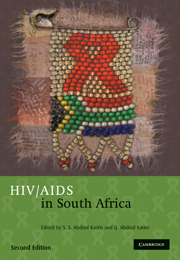Book contents
- Frontmatter
- Contents
- List of Contributors
- Foreword: Peter Piot
- Foreword: Nelson R Mandela
- Acknowledgements
- Section 1 Birth of a rapidly growing epidemic
- Section 2 The virus, the human host and their interactions
- Section 3 HIV risk factors and prevention strategiess
- Section 4 Focal groups for understanding the HIV epidemic
- Section 5 The impact of AIDS
- Section 6 Treating HIV
- 27 Tuberculosis and HIV
- 28 Prevention of opportunistic infections in adults
- 29 Nutritional prophylaxis
- 30 Challenges in managing AIDS in South Africa
- 31 Antiretroviral therapy
- 32 The challenges of implementing antiretroviral treatment in South Africa
- Section 7 What does the future hold?
- Index
28 - Prevention of opportunistic infections in adults
Published online by Cambridge University Press: 07 September 2011
- Frontmatter
- Contents
- List of Contributors
- Foreword: Peter Piot
- Foreword: Nelson R Mandela
- Acknowledgements
- Section 1 Birth of a rapidly growing epidemic
- Section 2 The virus, the human host and their interactions
- Section 3 HIV risk factors and prevention strategiess
- Section 4 Focal groups for understanding the HIV epidemic
- Section 5 The impact of AIDS
- Section 6 Treating HIV
- 27 Tuberculosis and HIV
- 28 Prevention of opportunistic infections in adults
- 29 Nutritional prophylaxis
- 30 Challenges in managing AIDS in South Africa
- 31 Antiretroviral therapy
- 32 The challenges of implementing antiretroviral treatment in South Africa
- Section 7 What does the future hold?
- Index
Summary
MORBIDITY AND MORTALITY IN HIV is largely a consequence of opportunistic infections that occur with impaired immunity. Combination antiretroviral therapy is the best way to prevent opportunistic infections, but even when antiretroviral therapy is used, these infections may still occur.
Nearly all opportunistic infections are caused by infectious agents, including malignancies associated with viruses. Virulent organisms, such as Mycobacterium tuberculosis, are also regarded as opportunistic infections as they occur more frequently in the hiv infected and cause more severe disease. Many are preventable and critical questions must be asked before selecting a prevention strategy. What is the incidence of the opportunistic infection? When in hiv infection does it occur? How effective and affordable is the preventive measure and what risks are associated with its use? Exposure to opportunistic infections should be prevented wherever possible by attention to safe water supplies, food hygiene, tb prevention and safe sex. Chemoprophylaxis has a major role in advanced infection. Immunisation is of limited benefit in the prevention of opportunistic infections and active immunisations should be given early in hiv infection.
Almost all the morbidity and mortality associated with hiv infection is a consequence of opportunistic diseases that occur when immunity is impaired. The best way to prevent opportunistic diseases is to improve the level of immune function using combination antiretroviral therapy. The use of antiretroviral therapy can reduce the incidence rate of opportunistic diseases by around 80%.
- Type
- Chapter
- Information
- HIV/AIDS in South Africa , pp. 479 - 488Publisher: Cambridge University PressPrint publication year: 2010



